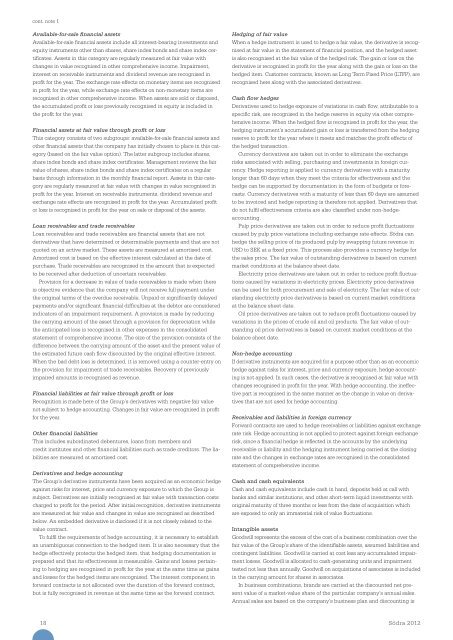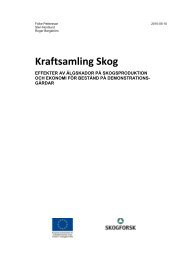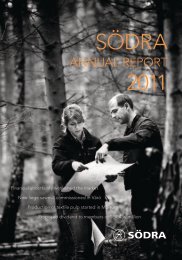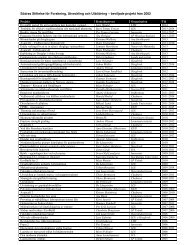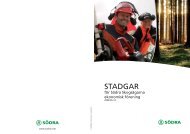Södra annual report 2012
Södra annual report 2012
Södra annual report 2012
You also want an ePaper? Increase the reach of your titles
YUMPU automatically turns print PDFs into web optimized ePapers that Google loves.
cont. note 1<br />
Available-for-sale financial assets<br />
Available-for-sale financial assets include all interest-bearing investments and<br />
equity instruments other than shares, share index bonds and share index certificates.<br />
Assets in this category are regularly measured at fair value with<br />
changes in value recognised in other comprehensive income. Impairment,<br />
interest on receivable instruments and dividend revenue are recognised in<br />
profit for the year. The exchange rate effects on monetary items are recognised<br />
in profit for the year, while exchange rate effects on non-monetary items are<br />
recognised in other comprehensive income. When assets are sold or disposed,<br />
the accumulated profit or loss previously recognised in equity is included in<br />
the profit for the year.<br />
Financial assets at fair value through profit or loss<br />
This category consists of two subgroups: available-for-sale financial assets and<br />
other financial assets that the company has initially chosen to place in this category<br />
(based on the fair value option). The latter subgroup includes shares,<br />
share index bonds and share index certificates. Management reviews the fair<br />
value of shares, share index bonds and share index certificates on a regular<br />
basis through information in the monthly financial <strong>report</strong>. Assets in this category<br />
are regularly measured at fair value with changes in value recognised in<br />
profit for the year. Interest on receivable instruments, dividend revenue and<br />
exchange rate effects are recognised in profit for the year. Accumulated profit<br />
or loss is recognised in profit for the year on sale or disposal of the assets.<br />
Loan receivables and trade receivables<br />
Loan receivables and trade receivables are financial assets that are not<br />
derivatives that have determined or determinable payments and that are not<br />
quoted on an active market. These assets are measured at amortised cost.<br />
Amortised cost is based on the effective interest calculated at the date of<br />
purchase. Trade receivables are recognised in the amount that is expected<br />
to be received after deduction of uncertain receivables.<br />
Provision for a decrease in value of trade receivables is made when there<br />
is objective evidence that the company will not receive full payment under<br />
the original terms of the overdue receivable. Unpaid or significantly delayed<br />
payments and/or significant financial difficulties at the debtor are considered<br />
indicators of an impairment requirement. A provision is made by reducing<br />
the carrying amount of the asset through a provision for depreciation while<br />
the anticipated loss is recognised in other expenses in the consolidated<br />
statement of comprehensive income. The size of the provision consists of the<br />
difference between the carrying amount of the asset and the present value of<br />
the estimated future cash flow discounted by the original effective interest.<br />
When the bad debt loss is determined, it is removed using a counter-entry on<br />
the provision for impairment of trade receivables. Recovery of previously<br />
impaired amounts is recognised as revenue.<br />
Financial liabilities at fair value through profit or loss<br />
Recognition is made here of the Group’s derivatives with negative fair value<br />
not subject to hedge accounting. Changes in fair value are recognised in profit<br />
for the year.<br />
Other financial liabilities<br />
This includes subordinated debentures, loans from members and<br />
credit institutes and other financial liabilities such as trade creditors. The liabilities<br />
are measured at amortised cost.<br />
Derivatives and hedge accounting<br />
The Group’s derivative instruments have been acquired as an economic hedge<br />
against risks for interest, price and currency exposure to which the Group is<br />
subject. Derivatives are initially recognised at fair value with transaction costs<br />
charged to profit for the period. After initial recognition, derivative instruments<br />
are measured at fair value and changes in value are recognised as described<br />
below. An embedded derivative is disclosed if it is not closely related to the<br />
value contract.<br />
To fulfil the requirements of hedge accounting, it is necessary to establish<br />
an unambiguous connection to the hedged item. It is also necessary that the<br />
hedge effectively protects the hedged item, that hedging documentation is<br />
prepared and that its effectiveness is measurable. Gains and losses pertaining<br />
to hedging are recognised in profit for the year at the same time as gains<br />
and losses for the hedged items are recognised. The interest component in<br />
forward contracts is not allocated over the duration of the forward contract,<br />
but is fully recognised in revenue at the same time as the forward contract.<br />
Hedging of fair value<br />
When a hedge instrument is used to hedge a fair value, the derivative is recognised<br />
at fair value in the statement of financial position, and the hedged asset<br />
is also recognised at the fair value of the hedged risk. The gain or loss on the<br />
derivative is recognised in profit for the year along with the gain or loss on the<br />
hedged item. Customer contracts, known as Long Term Fixed Price (LTFP), are<br />
recognised here along with the associated derivatives.<br />
Cash flow hedges<br />
Derivatives used to hedge exposure of variations in cash flow, attributable to a<br />
specific risk, are recognised in the hedge reserve in equity via other comprehensive<br />
income. When the hedged flow is recognised in profit for the year, the<br />
hedging instrument’s accumulated gain or loss is transferred from the hedging<br />
reserve to profit for the year where it meets and matches the profit effects of<br />
the hedged transaction.<br />
Currency derivatives are taken out in order to eliminate the exchange<br />
risks associated with selling, purchasing and investments in foreign currency.<br />
Hedge <strong>report</strong>ing is applied to currency derivatives with a maturity<br />
longer than 60 days when they meet the criteria for effectiveness and the<br />
hedge can be supported by documentation in the form of budgets or forecasts.<br />
Currency derivatives with a maturity of less than 60 days are assumed<br />
to be invoiced and hedge <strong>report</strong>ing is therefore not applied. Derivatives that<br />
do not fulfil effectiveness criteria are also classified under non-hedgeaccounting.<br />
Pulp price derivatives are taken out in order to reduce profit fluctuations<br />
caused by pulp price variations including exchange rate effects. Södra can<br />
hedge the selling price of its produced pulp by swapping future revenue in<br />
USD to SEK at a fixed price. This process also provides a currency hedge for<br />
the sales price. The fair value of outstanding derivatives is based on current<br />
market conditions at the balance sheet date.<br />
Electricity price derivatives are taken out in order to reduce profit fluctuations<br />
caused by variations in electricity prices. Electricity price derivatives<br />
can be used for both procurement and sale of electricity. The fair value of outstanding<br />
electricity price derivatives is based on current market conditions<br />
at the balance sheet date.<br />
Oil price derivatives are taken out to reduce profit fluctuations caused by<br />
variations in the prices of crude oil and oil products. The fair value of outstanding<br />
oil price derivatives is based on current market conditions at the<br />
balance sheet date.<br />
Non-hedge accounting<br />
If derivative instruments are acquired for a purpose other than as an economic<br />
hedge against risks for interest, price and currency exposure, hedge accounting<br />
is not applied. In such cases, the derivative is recognised at fair value with<br />
changes recognised in profit for the year. With hedge accounting, the ineffective<br />
part is recognised in the same manner as the change in value on derivatives<br />
that are not used for hedge accounting.<br />
Receivables and liabilities in foreign currency<br />
Forward contracts are used to hedge receivables or liabilities against exchange<br />
rate risk. Hedge accounting is not applied to protect against foreign exchange<br />
risk, since a financial hedge is reflected in the accounts by the underlying<br />
receivable or liability and the hedging instrument being carried at the closing<br />
rate and the changes in exchange rates are recognised in the consolidated<br />
statement of comprehensive income.<br />
Cash and cash equivalents<br />
Cash and cash equivalents include cash in hand, deposits held at call with<br />
banks and similar institutions, and other short-term liquid investments with<br />
original maturity of three months or less from the date of acquisition which<br />
are exposed to only an immaterial risk of value fluctuations.<br />
Intangible assets<br />
Goodwill represents the excess of the cost of a business combination over the<br />
fair value of the Group’s share of the identifiable assets, assumed liabilities and<br />
contingent liabilities. Goodwill is carried at cost less any accumulated impairment<br />
losses. Goodwill is allocated to cash-generating units and impairment<br />
tested not less than <strong>annual</strong>ly. Goodwill on acquisitions of associates is included<br />
in the carrying amount for shares in associates.<br />
In business combinations, brands are carried at the discounted net present<br />
value of a market-value share of the particular company’s <strong>annual</strong> sales.<br />
Annual sales are based on the company’s business plan and discounting is<br />
18<br />
Södra <strong>2012</strong>


